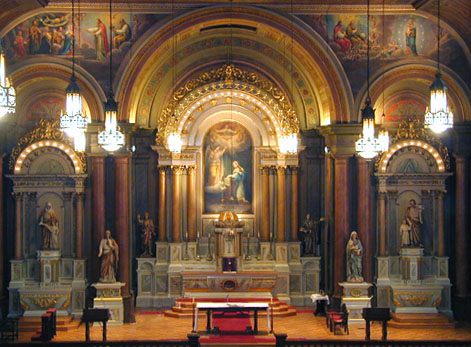The architectural style of St. Mary’s is eclectic. The engaged pilasters and classical entablature are in the Greek Revival style. The round windows of the facade add a touch of the Baroque, while the frames of the window and the ogive and quatrefoil openings in the tower show signs of the 19th century’s growing interest in Romanesque and Gothic.
In 1842, a clock was installed in the steeple of St. Mary’s. The original face and mechanism are still in place, but the weights and pendulum were removed when the clock was electrified over 100 years after its installation. St. Mary’s is the oldest clock tower in Cincinnati, and one of the oldest in the United States.

The first bell was blessed and placed in the tower in 1843. It was cast in Cincinnati by Levi Coffin, who was head of the underground railroad and who personally helped over 3,000 slaves to escape to Canada. After it was installed, the bell served many years as the fire alarm for the northeastern section of the city.
The interior of the church is richly embellished both with works of art and objects of devotion. Especially noteworthy are three oil paintings of the Blessed Virgin Mary above the main altar. Fifteen feet high, the paintings are changed at appropriate seasons of the year, being hoisted into place by a system of pulleys. Visible under the high altar are the bones of a woman martyr discovered in 1844 in the Roman catacombs and brought to Cincinnati by Father Clemens Hammer, first pastor of St. Mary’s.
ad maiorem dei gloriam
